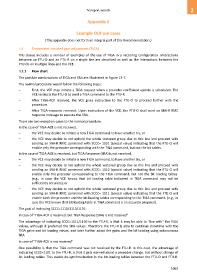Page 1073 - 5G Basics - Core Network Aspects
P. 1073
Transport aspects 2
Appendix II
Example OLR use cases
(This appendix does not form an integral part of this Recommendation.)
II.1 Transmitter initiated gain adjustment (TIGA)
This clause includes a number of examples of the use of TIGA in a vectoring configuration. Interactions
between an FTU-O and an FTU-R on a single line are described as well as the interactions between the
FTU-Os on multiple lines and the VCE.
II.1.1 Flow chart
The possible combinations of TIGA and SRA are illustrated in Figure 13-7.
The normal procedure would follow the following steps:
– First, the VCE may initiate a TIGA request when a precoder coefficient update is scheduled. The
VCE instructs the FTU-O to send a TIGA command to the FTU-R.
– After TIGA-ACK received, the VCE gives instruction to the FTU-O to proceed further with the
procedure.
– After TIGA-response received: Upon instruction of the VCE, the FTU-O shall send an SRA-R RMC
response message to execute the SRA.
There are two exception cases to the normal procedure:
In the case of TIGA-ACK is not received,
– the VCE may decide to initiate a new TIGA command, to have another try, or
– the VCE may decide to not uphold the whole vectored group due to this line and proceed with
sending an SRA-R RMC command with SCCC= 1101 (special value) indicating that the FTU-O will
enable only the precoder corresponding with the TIGA command, but not the bit tables.
In the case of TIGA-ACK is received, but TIGA Response (SRA) is not received,
– the VCE may decide to initiate a new TIGA command, to have another try, or
– the VCE may decide to not uphold the whole vectored group due to this line and proceed with
sending an SRA-R RMC command with SCCC= 1110 (special value) indicating that the FTU-O will
enable only the precoder corresponding to the TIGA command, but not the bit loading tables.
(e.g., in case the VCE knows that bit loading table indicated in TIGA command may not be
sufficiently accurate), or
– the VCE may decide to not uphold the whole vectored group due to this line and proceed with
sending an SRA-R RMC command with SCCC= 1111 (special value) indicating that the FTU-O will
enable both the precoder and the bit loading tables corresponding to the TIGA command. (e.g., in
case the VCE knows that bit loading table in TIGA command is an accurate proposal).
The goal of indicating SCCC=1111/1110/1101:
In case of "TIGA-ACK is received, but TIGA Response (SRA) is not received"
The advantage of indicating SCCC=1111/1110 to the FTU-R, is that it may be able to "live with" the TIGA
values, although it preferred the SRA values. Therefore the FTU-R is able to continue showtime with the
TIGA gains and bit loading values, and later further adapt the gains and the bit loading using autonomous
SRA.
In case of "TIGA-ACK is not received"
One possibility is that the TIGA command was not received by the FTU-R. In this case, the advantage of
indicating SCCC=1101 to the FTU-R, is that it gets warned about a precoder change, but without change of
bit loading tables. This avoids de-synchronization in the bit-loading tables between the FTU-O and FTU-R.
1063

